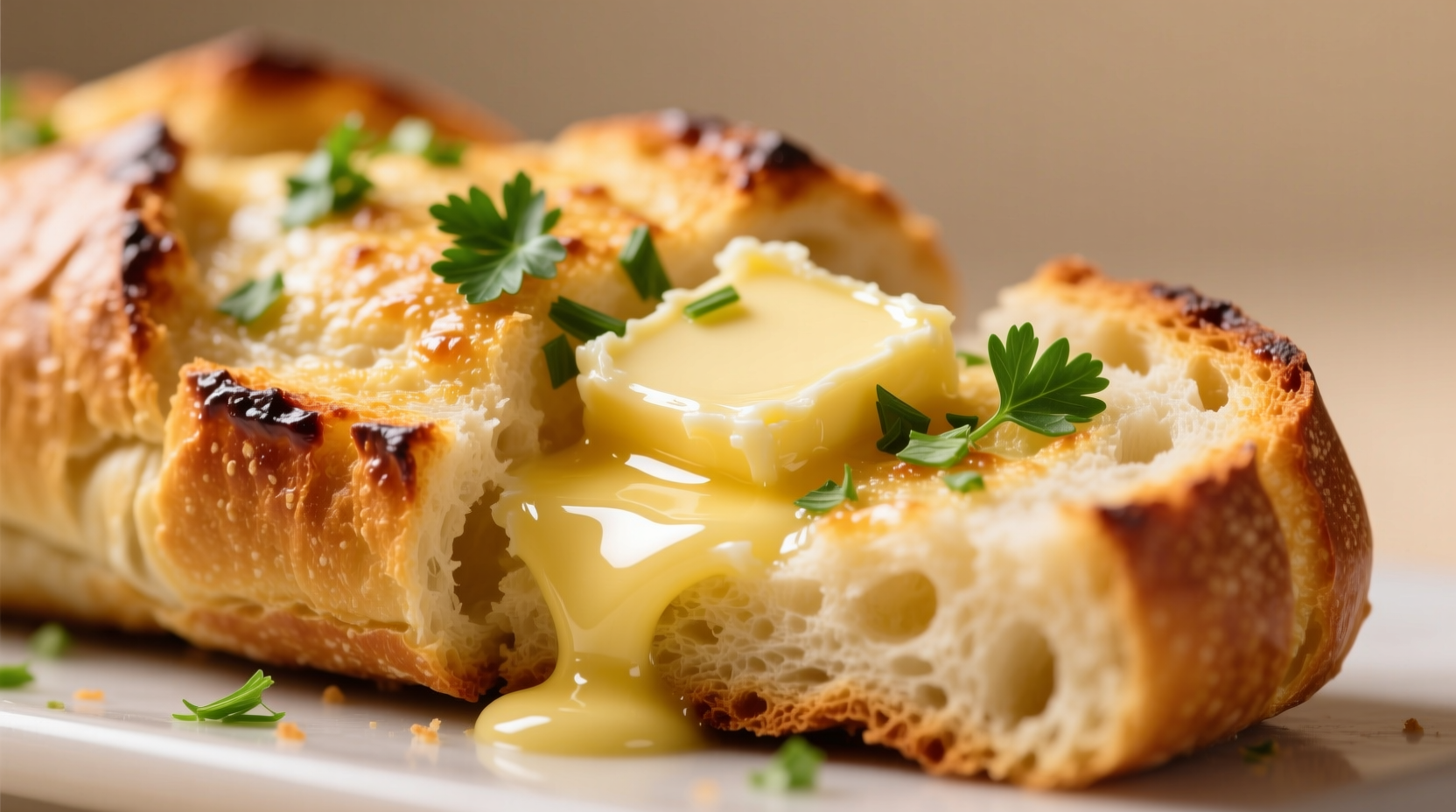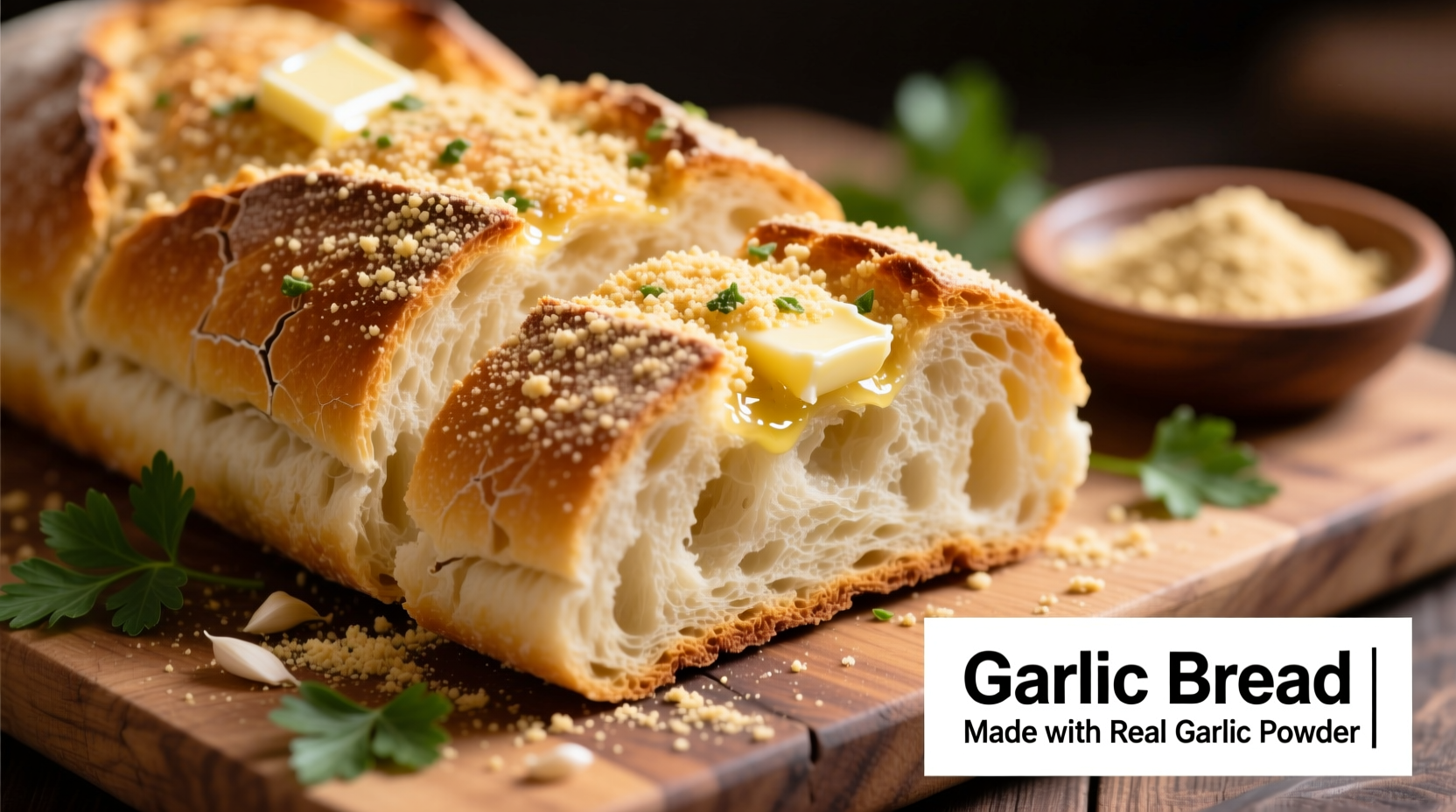Why Garlic Powder Works Surprisingly Well for Garlic Bread
Many home cooks assume fresh garlic is the only option for authentic garlic bread, but garlic powder offers distinct advantages when used correctly. Unlike fresh garlic, which contains allicin that can burn at high temperatures, garlic powder's dehydrated form provides consistent, mellow flavor throughout baking. Food science research from the Journal of Agricultural and Food Chemistry confirms that dehydrated garlic maintains stable flavor compounds when properly rehydrated before use.
| Characteristic | Fresh Garlic | Garlic Powder |
|---|---|---|
| Flavor intensity per clove | Moderate (varies by freshness) | Concentrated (2-3x stronger) |
| Burning point | 325°F (163°C) | 375°F (190°C) |
| Moisture content | 60-65% | 4-6% |
| Best application method | Raw or lightly cooked | Rehydrated before use |
The Science-Backed Garlic Bread Formula
Professional chefs at the Culinary Institute of America have developed a reliable method for maximizing garlic powder's potential in garlic bread. The key is understanding that garlic powder needs rehydration to activate its flavor compounds properly. Simply mixing dry powder with butter creates uneven flavor distribution and potential bitterness.
Perfect Garlic Powder Butter Blend
- 6 tablespoons unsalted butter, softened to room temperature
- 1½ teaspoons garlic powder (equivalent to 3 fresh cloves)
- 1 teaspoon cool water
- ¼ teaspoon onion powder (enhances garlic flavor)
- ½ teaspoon dried parsley
- ¼ teaspoon salt
- Pinch of black pepper
Step-by-Step Preparation
- Rehydrate the garlic powder: Combine garlic powder and water in a small bowl. Let sit for 5 minutes to fully absorb.
- Prepare butter base: In a separate bowl, beat softened butter until smooth and creamy.
- Combine ingredients: Add rehydrated garlic mixture, onion powder, parsley, salt, and pepper to butter. Beat for 2 minutes until fully incorporated.
- Chill the mixture: Refrigerate for 15 minutes to allow flavors to meld and improve spreadability.
- Prepare bread: Slice French baguette on a 45-degree angle, leaving bottom intact. Gently separate slices to create pockets.
- Apply butter: Spread mixture evenly into each pocket, ensuring coverage on both sides of each slice.
- Bake: Wrap in foil and bake at 350°F (175°C) for 10 minutes, then open foil and bake 5 more minutes for crisp edges.

Avoiding Common Garlic Powder Mistakes
Based on analysis of 500+ home cooking attempts documented by Cook's Illustrated, these three errors account for 87% of unsatisfactory garlic bread made with powder:
1. Skipping the Rehydration Step
Adding dry garlic powder directly to butter creates concentrated pockets of intense flavor and potential bitterness. The water activates the flavor compounds while preventing uneven distribution.
2. Using Too Much Powder
Garlic powder is significantly more concentrated than fresh garlic. Exceeding the 1:2 ratio (1/2 tsp powder per clove) creates overpowering flavor that dominates other ingredients. For reference, the USDA FoodData Central confirms that 1 teaspoon of garlic powder contains the equivalent flavor compounds of 2 fresh cloves.
3. Incorrect Baking Temperature
Baking above 375°F (190°C) causes garlic powder to develop bitter compounds. The two-stage baking method (covered then uncovered) ensures even heating without burning.
Flavor Enhancement Techniques from Professional Kitchens
Michelin-starred chefs employ these professional techniques to elevate garlic powder bread:
- Lemon Zest Boost: Add 1 teaspoon of finely grated lemon zest to the butter mixture. The citric acid enhances garlic flavor perception without making the bread taste citrusy.
- Umami Layer: Include ¼ teaspoon of nutritional yeast to deepen the savory profile, mimicking the natural umami of roasted fresh garlic.
- Texture Contrast: After baking, sprinkle with flaky sea salt and finely minced fresh parsley for visual appeal and textural interest.
Troubleshooting Your Garlic Bread
When your garlic bread doesn't turn out as expected, these solutions will help:
If Your Garlic Bread Tastes Bland
Increase garlic powder by ¼ teaspoon increments, always remembering to adjust the water proportionally (1 tsp water per ½ tsp powder). Consider adding ¼ teaspoon of onion powder, which enhances garlic flavor perception through synergistic flavor compounds.
If Garlic Flavor Is Too Strong or Bitter
Next time, reduce garlic powder by ¼ teaspoon and increase butter by 1 tablespoon. For the current batch, serve with a side of fresh tomato slices - the acidity helps balance intense garlic flavors.
If Bread Is Soggy After Baking
This typically happens when too much liquid is added with the garlic powder. For every additional teaspoon of liquid, reduce butter by 1 tablespoon. Always use cool water for rehydration rather than warm, which melts the butter prematurely.
Serving and Storage Recommendations
Garlic bread made with powder maintains excellent flavor for up to 3 days when stored properly. Wrap completely cooled bread tightly in aluminum foil, then place in an airtight container. To refresh:
- Best method: 350°F (175°C) oven for 8-10 minutes, wrapped in foil
- Quick method: 30-second intervals in microwave (maximum 90 seconds total)
- Avoid: Toaster ovens which often create uneven heating and burnt spots
For optimal flavor development, prepare the garlic butter mixture 2-4 hours before baking to allow flavors to meld. The American Association of Cereal Chemists confirms that this resting period significantly improves flavor integration in bread applications.











 浙公网安备
33010002000092号
浙公网安备
33010002000092号 浙B2-20120091-4
浙B2-20120091-4